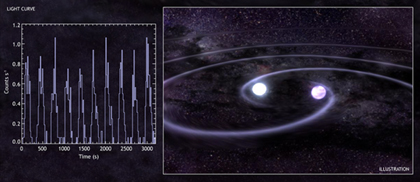May 30, 2005
NASA RELEASE 05-136
A scientist using NASA's Chandra X-ray Observatory has found evidence that two white dwarf stars are orbiting each other in a death grip, destined to merge. The data indicate that gravitational waves are carrying energy away from the star system at a prodigious rate - making it a prime candidate for future missions designed to directly detect these subtle ripples in space-time.
Einstein's General Theory of Relativity predicts that a binary star system should emit gravitational waves, which rush away at the speed of light and cause the stars to move closer together. The orbital period of this system, known as RX J0806.3+1527, or J0806, is decreasing by 1.2 milliseconds every year, a rate consistent with theory.
The white dwarf pair in J0806 might have the smallest orbit of any known binary system with the stars only about 50,000 miles apart, a fifth of the distance from the Earth to the Moon. As the stars swirl closer together, traveling in excess of a million miles per hour, the production of gravitational waves increases.
"If confirmed, J0806 could be one of the brightest sources of gravitational waves in our Galaxy," said Tod Strohmayer of NASA's Goddard Space Flight Center of Greenbelt, Md., who presents his results today at the American Astronomical Society meeting in Minneapolis, Minn. "It could be among the first to be detected directly with an upcoming space mission called LISA, the Laser Interferometer Space Antenna."
White dwarfs are remnants of stars like our Sun that have used up all their fuel. Along with neutron stars and black holes, white dwarfs are called compact objects because they pack a lot of mass into a small volume. The white dwarfs in the J0806 system each have an estimated mass half that of the Sun, yet are only about the size of Earth.
Optical and X-ray observations of J0806 show periodic variations with a period of 321.5 seconds - barely more than five minutes. The observed five-minute period in J0806 is most likely the orbital period of the white dwarf system. However the possibility that it represents the spin of one of its white dwarfs cannot yet be completely ruled out.
"It's either the most compact binary known or one of the most unusual systems we've ever seen," said Strohmayer. "Either way it's got a great story to tell."
Strohmayer's Chandra X-ray observations, which will be published in an upcoming issue of The Astrophysical Journal, tighten orbital decay estimates made through optical observations in recent years independently by teams led by GianLuca Israel of the Astronomical Observatory of Rome and by Pasi Hakala of the University of Helsinki.
NASA's Marshall Space Flight Center, Huntsville, Ala., manages the Chandra program for NASA's Science Mission Directorate, Washington. Northrop Grumman of Redondo Beach, Calif., was the prime development contractor for the observatory. The Smithsonian Astrophysical Observatory controls science and flight operations from the Chandra X-ray Center in Cambridge, Mass.
Additional information and images are available at:
MEDIA CONTACTS
Erica Hupp
Headquarters, Washington
Phone: 202/358-1237
Megan Watzke
Chandra X-ray Center, Cambridge, Mass.
Phone: 617-496-7998





